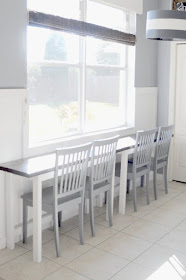Okay, so I had a kitchen table and whenever I needed more space or was mopping, I would push it up against the window. It made the kitchen so much bigger! I loved it and so did my Husband, but the designer in me hated it. So, here was my newly created problem... push it against the wall and have space, or in the middle and have it be functional....
Well I love a good problem...
Let me preface this with a disclaimer. I have never used Auto Cad before and this was my first attempt, so no judging.
Now that, that is all cleared up, let’s make
a table! (Well, 2 to be exact.)
Here is your shopping list:
3- 2"x6"
(8')
$6.00 x 3 = $18.00
6- 2"x3"
(8')
$2.00 x 6 = $12.00
2- "1x3"
(8')
$2.00 x 2
= $ 4.00
Est lumber = $ 34.00ish
You will also need:
-sandpaper
-paint and/or stain (I used Jacobean by Minwax for the
top and Behr Ultra White for base)
-paint brushes
- 2 1/2" Screws
-3 1/2" Screws
-3 1/2" Screws
- Brad nails (either hand drive or for nail gun)
-Wood filler
-Wood filler
Tools Suggested:
- Miter Saw
- Electric Hand Sander
- Drill
- Brad nailer or hammer
- Kreg Jig
Okay, so you have visited your local hardware. (I am
personally a Home Depot Girl), we are ready to start cutting!
Cut list:
2x3's
4 @ 39" (top support, footrest)
8 @ 29" (legs)
4 @ 13" (top side supports)
4 @ 11" (bottom side supports)
2x6's
6 @ 48" (top planks)
1x3's
4 @ 11" (side fronts)
2 @ 39" (front)
At this stage I personally double check and make sure all measurements that are supposed to be the same are EXACTLY the same. If there are any discrepancies I even them out.
Then go crazy with the sander.
Now, I know some people prefer to apply paint or stain
after everything is put together, not me. I hate trying to paint all the
surfaces on a 3D object, flat boards are easier. Like I said personal
preference. I undoubtedly will end up doing some touch-ups, but I
still say it is easier.
Assembly
Okay, lets do this...
-Center your 11" 1x3 on the 13" 2x3, there should be 1.5" space on either side.
-Secure the 1x3 to the 2x3. If you have a nail gun, use it, if not use a hammer and brad nails, or wood glue.---
-Pre-drill and fasten the the 13" 2x3 to the back of the legs using 2 1/2" screws.
-Take your 11" 2x3" and secure it so that the base of the new support is 3" from the bottom of the leg. If you have a kreg jig use it. If not you will need to pre-drill through the leg and use a 3 1/2" screw.
- Now do it all over again, 3 more times...
Still with me ? Good.
- Take one of your 39" 2x3's and secure it at the ends of your 13" 2x3's. (It should fit perfectly in the corner)
-Take your 39" 1x3 and secure it to the front. ( It will be inset about 3/4")
-Take your other 39" 2x3" and secure it so that the base of the new support is 3" from the bottom of the leg. Again if you have a kreg jig use it.
-Repeat on the other table.
Ok next comes the tops...
- I would strongly suggest having these stained/painted in advance, getting down in the cracks after this point could be near impossible.
- Lay 3 of your 2x6's side by side on the ground, with the "top" facing down, flip your table base upside down and lay directly on top of the 2x6's.
- Then predrill through your 2x3 supports so that your will have screws fastening all 3 of your 2x6 boards to the base.
- Flip over and marvel at your work, and then do it again.
Side notes, I know some people will wonder about the cracks, you can put a wood filler inbetween them, sand it down and then seal it. I did not do that on this table. I made the spacing between the boards large enough that I could clean between with a knife if needed and water would just go through. I have used the filler method before and it has to be very close and sealed very well to work. I had a problem with a seam that repeatedly popped on a kitchen table (actually it is what pushed me to make this table.) Whatever you do make sure your filler is able to be stained or painted depending on your finish.
Ta-da, problem solved, a table that could be functional even while pushed against the wall, and still be beautiful as a full kitchen table!







You're a rockstar my friend.
ReplyDeleteI love it! I'm going to use this in the school room! Such a good idea!
ReplyDeleteHow clever! Your instructions are great! Thanks.
ReplyDeleteThank you so much! I was pretty thrilled about them. Thanks for stopping by!
DeleteDid you make the chairs too? If yes, do you plans for those also? I love the table idea. I'm thinking of doing 3 stitches to make seating for 4,6, or 8
ReplyDeleteI wish I could claim the chairs, how ever those are just some old up-cycled chairs. I love the idea of making it bigger! If we ever require more than 4 seats, I would totally do it as well! I would love to see pictures of you do end up making a larger version! Good luck!
Delete